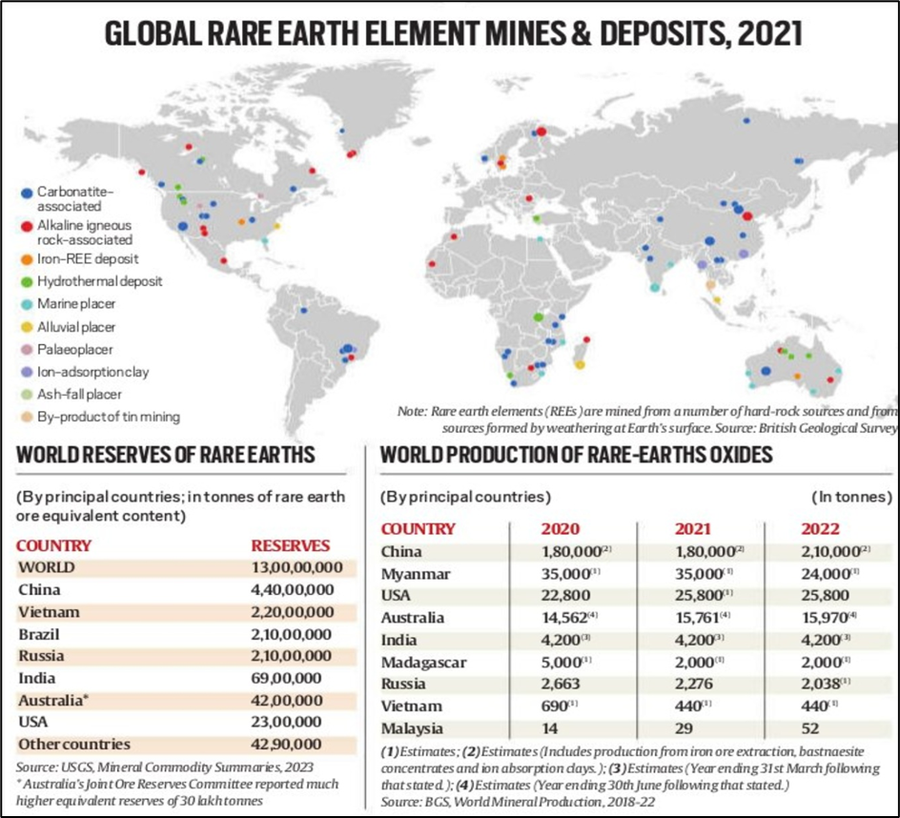Why in news?
The ongoing China–US trade conflict has intensified over rare earth minerals, a critical component for high-tech industries.
China recently tightened restrictions on rare earth exports, prompting US President Donald Trump to threaten 100% tariffs in retaliation.
What’s in Today’s Article?
- Rare Earths: Abundant in Nature, Critical in Technology, and Dominated by China
- China’s Rare Earth Dominance: Weaponising Trade Through Rare Earths
- New Restrictions on Rare Earth Exports
- India’s Domestic Initiatives and Future Plans
- Global Shifts Beyond China
Rare Earths: Abundant in Nature, Critical in Technology, and Dominated by China
- Rare earths refer to 17 metallic elements — from lanthanum (57) to lutetium (71), plus scandium (21) and yttrium (39) — known for their high density, conductivity, and thermal resistance.
- They are divided into light and heavy rare earths, based on atomic weight, and form an essential subset of critical minerals vital to modern industries.
- Why They Matter?
- These elements are indispensable, even in trace quantities, for a wide array of technologies — from smartphones, wind turbines, and electric vehicles to weapons systems, robotics, MRI scanners, and cancer treatment equipment.
- Their unique properties make them irreplaceable components in both civilian and defence applications, underpinning the global clean energy and digital revolutions.
- Rare earths typically occur in low concentrations, making extraction and refining expensive and environmentally complex.
- This high cost limits the number of countries that can profitably mine and process them.
- China’s Global Dominance
- According to the International Energy Agency (IEA):
- Over 60% of rare earth mining occurs in China.
- More than 90% of global processing and refining capacity is also controlled by Beijing.
- This near-monopoly gives China strategic leverage in global supply chains, making rare earths a central weapon in trade and geopolitical rivalries, especially with the United States.

- Global Reserves, Limited Production
- While Brazil, Australia, and India hold substantial rare earth reserves, their production remains minimal.
- The reasons include:
- Low economic viability due to high extraction costs, and
- Environmental concerns, as rare earth mining is highly polluting and requires complex waste management systems.
China’s Rare Earth Dominance: Weaponising Trade Through Rare Earths
- Beijing has pursued a deliberate industrial strategy to achieve near-total control over the mining and processing of these critical minerals, integrating them into its long-term economic and geopolitical planning.
- China’s export restrictions, particularly on heavy rare earths like terbium (65) and dysprosium (66) — essential for defence and high-tech manufacturing — are part of a policy to use rare earths as a strategic trade weapon.
- In response to US tariffs under President Donald Trump, Beijing has used its dominance in rare earths to gain leverage and escalation control in the ongoing US-China trade war.
- China’s decades-long investment in rare earth mining, refining, and technology has created a complete supply chain monopoly.
New Restrictions on Rare Earth Exports and Impact on India
- China has expanded its export control list to include five additional rare earth elements — holmium, erbium, thulium, europium, and ytterbium — along with related magnets and materials, bringing the total number of restricted elements to 12.
- The Ministry of Commerce also added refining technologies to the control list and announced that foreign producers using Chinese rare earths must now comply with its new export rules.
- Limited Impact on India—for Now
- India’s exposure to rare earth supply disruptions is relatively limited, owing to low domestic consumption.
- According to the Ministry of Mines, India imported 2,270 tonnes of rare earth elements in 2023–24, up 23% from 2019–20, with 65% sourced from China and 10% from Hong Kong.
- The auto sector (particularly EVs) and the electronics industry have felt the sharpest impact from earlier Chinese restrictions in April.
India’s Domestic Initiatives and Future Plans
- India’s rare earth production remains modest, led by state-owned IREL Ltd, which operates a processing unit with a capacity of over 10,000 tonnes per annum, compared to China’s 200,000 tonnes in 2023.
- However, India is actively expanding its footprint:
- Seven seabed blocks in the Andaman Sea have been auctioned for exploration and mining of polymetallic nodules and crusts that may contain heavy rare earths.
- The Department of Atomic Energy has cleared plans for a Rare Earths Theme Park to establish pilot plants across the value chain.
- Two major projects — the Rare Earth Permanent Magnet Park in Visakhapatnam and the Rare Earth and Titanium Theme Park in Bhopal — are being developed with central funding to strengthen India’s presence in this strategic sector.
Global Shifts Beyond China
- Globally, efforts to diversify the rare earth supply chain are gaining traction:
- The US is preparing an executive order to stockpile deep-sea metals from the Pacific seabed, reducing reliance on China for battery minerals and rare earths.
- Japan, which faced Chinese curbs in the early 2010s, has since rebuilt its rare earth supply chains, offering a potential model for India and Western economies seeking independence from Beijing’s control.










